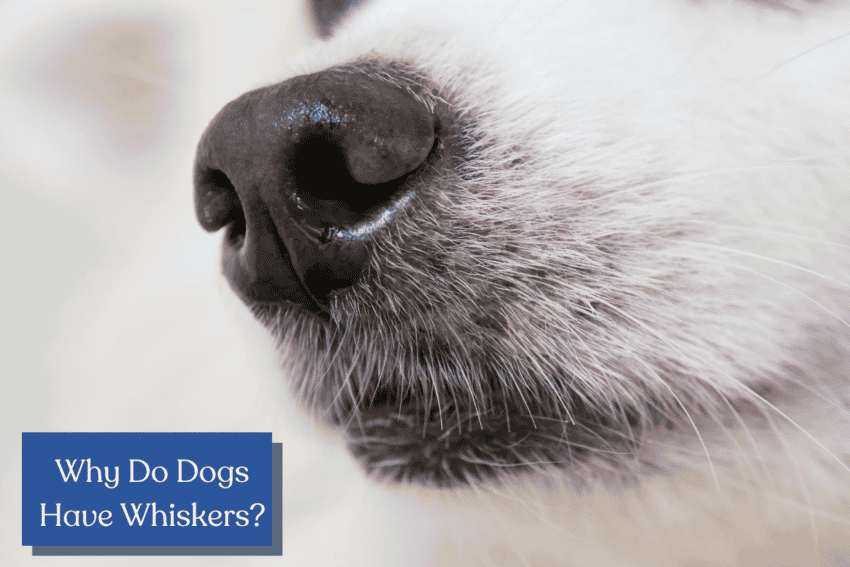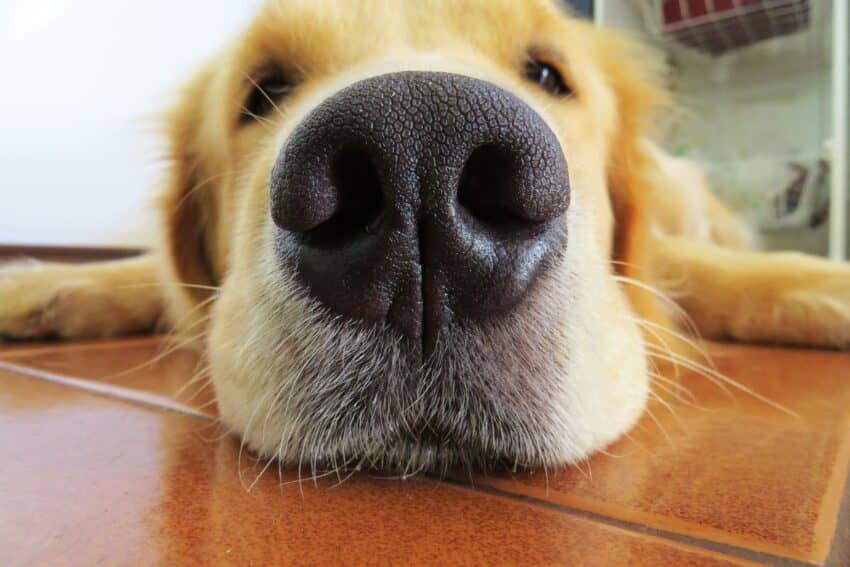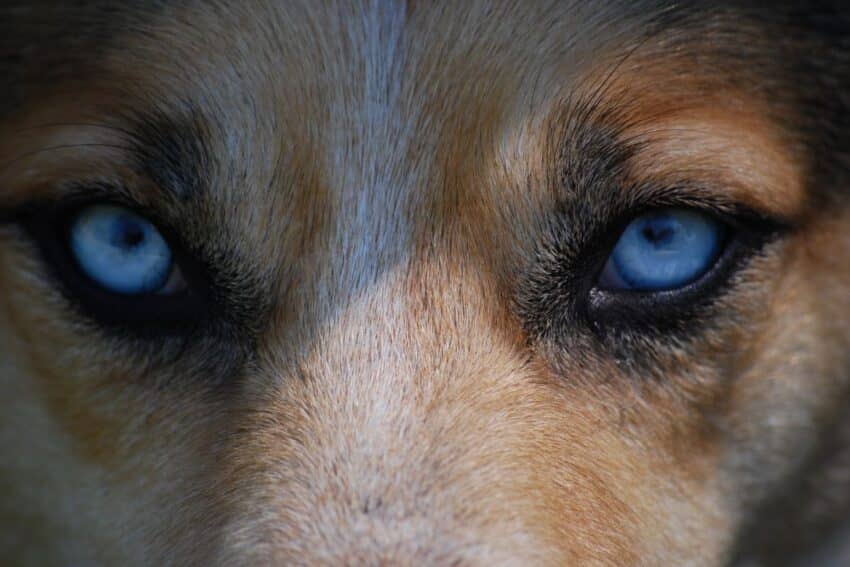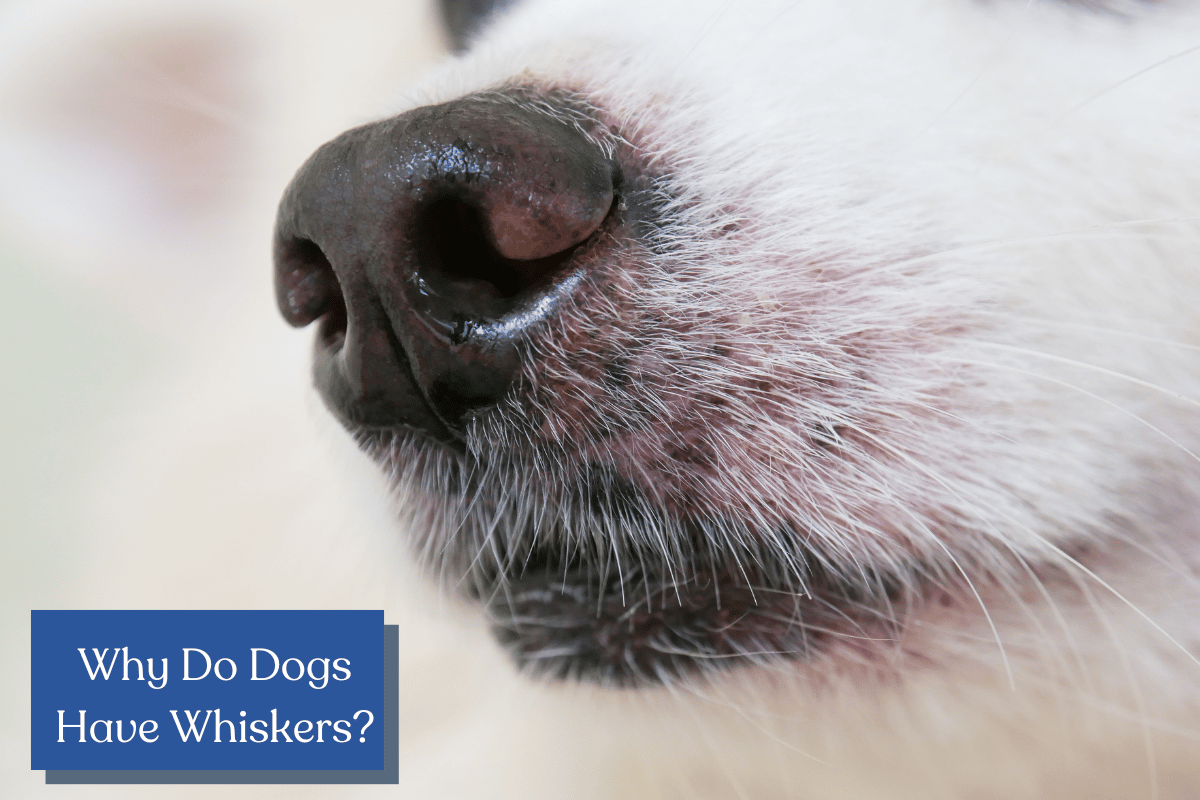Wondering why dogs have whiskers is a right of passage among canine owners. I can’t tell you how times people have asked me this question over the years. Finally, I decided to create a guide to answer all the relevant topics around your pup’s curious whiskers.
You’ll soon know the why, where, and if removing them is dangerous. So read on, and learn all about this vital part of your dog’s body. I’ll promise you’ll soon become an expert on all things dog whiskers!

What are Dog Whiskers?
I’m sure everyone reading this article is aware of dog whiskers. But knowing how to identify them before learning their purposes is vital. It’s an essential step in understanding why these whiskers are on your dog’s body.
The first thing to know about dog whiskers is they come out of hair follicles. In this way, whiskers aren’t different from all the hairs on your dog’s body. But their appearance makes them stand out much more than standard dog hair.
For instance, whiskers are thicker and coarser with deeper roots. So it’s easy to tell them apart from other hairs, especially since they don’t appear all over your pup’s body. Instead, whiskers are located on chins, above the eyes, and right under their nose: precise locations will change based on breed.
Another critical difference is whiskers are much more sensitive. It’s why owners need to be careful about pulling them out accidentally since their follicles are filled with nerves and blood vessels.
Plus, they’re a pivotal part of how dogs interact with the world around them(more on this later).
3 Reasons Why Dogs Have Whiskers
Dog whiskers provide three crucial functions for our furry friends. They’ll give them a better sense of their environment, provide protection, and communicate feelings. Let’s look at how they offer abilities and why they’re essential:
1. Senses the Environment Around Them
One of the more misunderstood parts about dogs is their eyesight. Most people assume it’s top-tier, like their hearing and smell, but it’s subpar in comparison. It’s a more significant issue with objects at close distances rather than further away objects.
In any case, this issue is where whiskers are extremely handy. These whiskers have follicles with clusters of tactile receptor cells that send signals to their brains. So if they come in contact with something up close, these whiskers will let the brain know what’s happening.
The depth of this ability is quite incredible. These whisker follicles can even pick up air currents that move them. Basically, these whiskers can detect the size, speed, and shape of any nearby objects through air current movement: incredible, right?
For instance, if a predator animal approaches them quickly, these whiskers will pick up their movements. It’ll allow your canine to adapt to whatever’s coming and plan to react. It’s a pivotal attribute, especially for dogs in the wild.
This same attribute is also helpful for them at home. It’ll allow them to locate their food bowls or favorite toys at night or in other low-light situations. It’s why your dog seems like a master when navigating a dark home without bumping into anything.
Another exciting thing about this sensory ability is how it helps with a dog’s early development. You see, dogs are born with these whiskers on their bodies. This allows newborn puppies to find their mother’s nipples without any issue.
It doesn’t matter that their eyes aren’t fully open: the whiskers do the job. It’s another thing in a long list of amazing facts about our furry friends.

2. Offers Protection
Dog whiskers are known for their ability to protect certain body parts. The most apparent example would be a dog’s eyes. For example, some dust lands on your dog’s whiskers during an adventure to get a toy from under your couch.
Essentially, the whiskers are a protective shield against this dust from falling into their eyes. It protects them from an irritant while offering an easy solution to completely eliminating it. All your dog has to do is blink or shake their heads to get it off their whiskers.
Another classic example would be whiskers helping dogs avoid tight situations. So these whiskers can help your dog identify whether it can fit into certain spaces. It’s why dogs rarely seem to get stuck when diving between the cushions or other narrow spots.
Of course, it doesn’t always work, as my Pitbull can tell you. She has a habit of getting stuck in situations where she can only get out with my help. Her last attempt was getting into my smaller dog’s crate and getting stuck inside (she couldn’t turn back around.)
3. Communicates Emotions
The last function dog whiskers serve is communicating emotions. It may sound ridiculous, but owners can infer a lot about how their dog feels through the whiskers. A happy or excited dog will have elevated whiskers, which gives them an adorable look of wonder. It’s the look every owner ends up giving into whenever they see it.
But whisker communication isn’t only showcasing happiness or excitement. Dogs will also flair their muzzle whiskers out and downward when feeling threatened. This whisker formation presents itself when they’re scared or feeling pain, too, as I see from my Beagle whenever there’s a thunderstorm.
Furthermore, whisker placement can communicate a dog being relaxed. You’ll notice the whiskers resting flat against their face whenever they feel stress-free. It’s common to see it whenever a dog’s sleeping or feeling completely safe in its environment.
A snore or dreaming sounds may even accompany it. Nothing is more adorable than a dog who dreams about chasing rabbits and letting their owner know about it.

Where Your Dog’s Whiskers Are Located
As I mentioned, whiskers aren’t on your dog’s entire body. There are specific locations where you will find them. It brings up an interesting question of where these locations are and why they’re located in those areas. So without further ado, let’s dive into our first whisker location:
1. Muzzle
Whiskers around a dog’s muzzle are often the most noticeable. Their technical term is called mystacial whiskers, but I bet you’ll stick to calling them whiskers. As for their purpose, they function much like humans use their fingertips.
Dogs have their muzzle whiskers extend toward approaching objects. Doing so lets them determine the shape and how close a nearby surface is to them. It’s an easy way to navigate their environment without relying on their subpar eyesight.

2. Eyes
Dogs will have a set of whiskers above the eyes called superciliary/supraorbital whiskers. Your pup will rely on them to detect threats and keep dirt or other substances out of their eyes. This set will focus much more on protection.
If they do detect a threat to the eyes, it’ll send a signal to your dog’s brain. Your puppy will then blink or shake their head to deal with the issue. It’s a crucial ability because very few things on earth are more annoying than an irritated eye.

3. Cheeks
Cheek whiskers (genal whiskers) are notable for their ability to help with navigation. These whiskers are the ones that often fail my Pitbull. In other words, this set will ensure your pup knows what tight spaces are safe and which are too cramped.
Another interesting tidbit about genal whiskers is they help your dog swim. You can expect them to keep your dog’s head upright while enjoying a nice summer lake swim. If only my dogs weren’t terrified of water, I could see it myself.

4. Chin
The last set of whiskers is located under your dog’s chin. Chin whiskers, also known as interramal whiskers, grow from a mole under the chin area. Dogs use them for providing sensory information to their brains, such as detecting food or water that’s not in their eye line.
So it’s a handy trait for wild dogs or any pup walking around at night. If you ever wonder how a dog can find their water bowl at midnight, it’s because of its chin whiskers!
Dangers of Removing Dog Whiskers
Extracting your dog’s whiskers isn’t a good idea. It removes a crucial part of how they interact with the world around them. So it’s best to leave them alone as much as possible unless necessary.
Now, I’d be doing a disservice if I didn’t mention some owners trim their dog’s whiskers. Experts haven’t been able to prove a slight trim affects their lives considerably. But it’s incredibly easy to chop off too much and cause disorientation.
Some other consequences include it being more difficult for your dog to swim. The trimmed whiskers won’t be able to keep their head upright. Your dog may also become overly cautious when walking due to the lack of feel and inference provided by their trimmed whiskers.
As a result, the best course of action is to leave your dog’s whiskers alone. If you need to trim them down, schedule an appointment with a vet or professional groomer. These experts will know how to trim them properly without causing any problems.
One common occurrence for necessary trimming is overgrown whiskers. It’s usually a practice used on show dogs to keep them from looking overly unkempt. But otherwise, there isn’t a single other reason to trim or remove your dog’s whiskers.
If you want to learn more about the perils of removing dog whiskers, check out this video. It provides a detailed look at all the consequences and shows why it’s a bad idea.
Do Dogs’ Whiskers Fall Out?
Whiskers do have a habit of falling out occasionally. It shouldn’t be a surprise, given whiskers are a type of hair. So they undergo a particular growth and shedding cycle miming what you can expect from regular dog hair.
So if you find a whisker or two on the ground, there’s no need to contact your vet immediately. It’s just a regular part of being a dog owner. Of course, if the whiskers start falling out rapidly, there is a reason to panic a little.
In these situations, contacting your vet should be the next move. They’ll figure out what’s causing the rapid whisker loss, whether it’s an infection or a condition like alopecia. Either way, your vet should provide a way to move forward.
Another possibility is that this whisker loss could result from a particular medication. So if you’ve been prescribed a new prescription for your dog, it could be causing the issue. It’s another reason follow-up appointments with vets are vital to ensure a dog’s health.
In doing so, It’ll allow them to adjust the dosage. It’s a simple way to ensure a successful experience with the meds rather than being stuck with the side effects.
Do Dog Whiskers Grow Back?
Dog owners who notice their pup’s whiskers have fallen off shouldn’t worry. Whiskers will grow back, but it takes longer than you might expect. Most experts agree that reaching their full length takes anywhere from 12 to 16 weeks.
I also should note that certain medical issues can affect the regrowth process. It may make them take longer than expected or grow differently. So don’t be surprised if the new whiskers look slightly different if your dog suffers from conditions like alopecia.
But the main takeaway here is that whiskers will grow back. Due to this, it isn’t the end of the world if your dog loses a whisker accidentally.
Conclusion
So why do dogs have whiskers? These whiskers are an advantageous way to sense, communicate, and protect themselves against the environment around them. Therefore, dog owners should do everything possible to ensure their pup’s whiskers are in good shape.
Let me know if you have more questions about dog whiskers in our comment section. I’d answer every post as soon as possible to ensure you feel confident in knowing everything about this topic. Thanks for reading!
Which of these reasons why dogs have whiskers did you find most interesting? Share your thoughts below!


